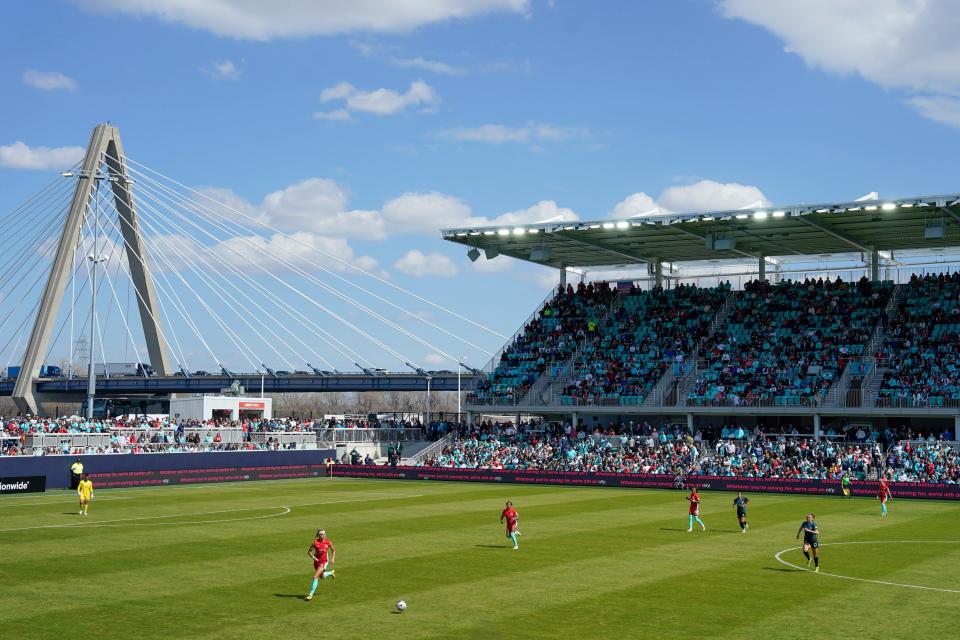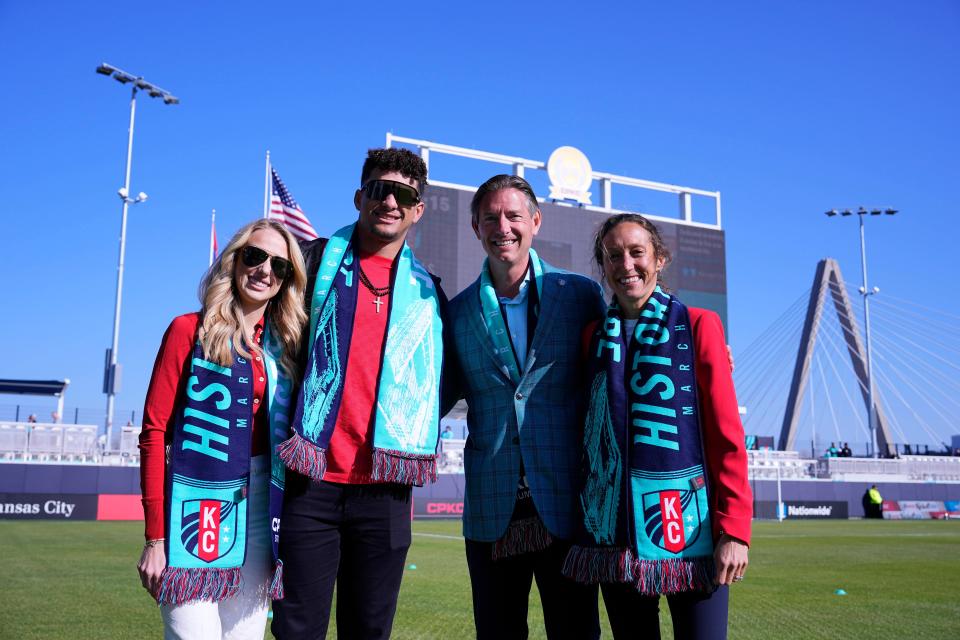Homes of their own critical for continued growth of women's sports. Stadiums equal revenue
Now that sponsors and broadcast executives have finally recognized there’s a market for women’s sports and owners have stopped seeing their teams as charity projects, the next step in leveling the playing field is facilities.
Specifically, stadiums and arenas of their own that will generate the revenue streams that have made men’s teams so financially successful and dedicated training facilities that will improve performance on the field.
“It’s a $20 million annual revenue swing. That effectively doubles what our organization is doing from a top-line basis,” Kansas City Current co-owner Chris Long said of the new CPKC Stadium, the first purpose-built stadium for a women’s team.
“As more clubs understand the gravity of what facilities mean more broadly, they're going to figure out that that return on investment is well worth it, and that they should be putting that investment in the ground,” Long added. “And that's just the financial side. There's also the community side, what it does for the players, the coaching staff and the people that want to come work for you because you have such proper elite facilities.
“It's this never-ending benefit that you bring by making that investment.”
The WNBA began in 1997 and the first professional women’s soccer league followed six years later. For much of that time, the teams — and their players — have been treated as second-class citizens. They played their games on high school fields and at far-flung arenas and stadiums. If they were lucky, men’s teams allowed them to “share” their space, using the same building but not reaping the same financial benefits.

Their training facilities were often sub-par, as well. It was only two years ago the Orlando Pride didn’t even have porta-potties at its practice fields. Almost three years after winning the WNBA title, the Chicago Sky still works out at a rec center in the northern suburbs.
But as the financial equations in women’s sports have changed, there’s been a recognition teams and athletes need more. Deserve more.
The San Diego Wave are being sold in a two-part deal that values the team at $113 million, Sportico reported on March 14. The Golden State Warriors paid $50 million for an expansion team in the WNBA last year, and the Wall Street Journal reported the Seattle Storm has a valuation of $151 million.
When there’s that much money involved, owners are expecting something in return. And the fastest way to those financial returns is through their own facilities.
“This, to me, was just one thing that made so much sense,” said Angie Long, who with co-owner and husband Chris has built a training facility, the first specifically for a women’s team, and now CPKC Stadium since buying the Current in 2021.
“Why weren’t there facilities? Why did people invest in women’s sports at all? Why were they continuing to manage them like a charity?” Angie Long said. “It’s the same as playing to not lose. You don’t play to not lose, you play to win. You don’t invest in a sports team to not lose money. You invest in it for what it means, what it builds and to make money.
“It was hard to envision doing that without the facilities.”
When you own or control your own building, you reap a multitude of benefits. CPKC paid the Current for the privilege of putting their name on the stadium, while the team did a separate deal with Helzberg Diamonds for naming rights to the main entry gate.
The ancillary game-day revenue — think concessions, merchandise, parking — goes to you, not someone else. Not only are you not paying someone else rent, you can rent your building out if you want — charging your guests accordingly, of course.
Your schedule is your own, too.
“When you’re a tenant, you basically take what is given to you. Usually, in our case, we’re second or third in line,” NWSL commissioner Jessica Berman said. “We can’t make our schedule until MLS makes their schedule. That makes it really hard. Particularly when we’re trying to optimize our media deals. We’re trying to fit into broadcast windows … and triangulating around stadium availability when you’re the second or third option is like putting a square peg in a round hole.”
OPINION: Men's pro teams have been getting subsidies for years. Time for women to get them, too.
Having exclusive training facilities pays dividends, too. Again, you don’t need to work around anyone else’s schedule. Players can come in at all hours of the day, at any time of the year, to practice and train. Treatment and recovery work can be done completely in house, rather than sending players out for, say, massage therapy or PT.
And this might seem like a small thing, but players can leave shampoo, clothes and anything they want in their lockers, knowing no one else will be in their space.
Their own locker room in their OWN stadium. 💅@michelle1cooper taking a victory lap 🤣 pic.twitter.com/uJxk6ZrLbo
— KC Current (@thekccurrent) March 13, 2024
"I have not had a locker in my entire career,” future Hall of Famer Candace Parker said of the importance of the Las Vegas Aces having their own training facility during an appearance on Draymond Green’s podcast last March. "I’ve been in the WNBA for 16 years and I have not had a locker where it has my name on it and I can leave my (stuff) and then come back and know my (stuff) is going to be there.”
It is not a coincidence that the biggest players in WNBA free agency the last two seasons were teams that invested in new or updated facilities.
The Aces, whose state-of-the-art training facility opened last year, and the New York Liberty, which revamped their locker room after their move to Barclays Center, built super teams ahead of last season and then faced off in the WNBA Finals.
This year, the Phoenix Mercury got Natasha Cloud, Kahleah Copper and Rebecca Allen. This followed new owner Mat Ishbia’s announcement last fall that he planned to build the Mercury its own training facility as part of a new, $100 million headquarters for the Mercury and the Sun. The Seattle Storm, which plans to open its new, 50,000-square foot practice facility before training camp starts, signed Nneka Ogwumike and Skylar Diggins-Smith.
“It's important to invest in women. Invest in women and you see the results that come out of it. People want to play there. People want to come and be a part of something special like that,” Copper said after she engineered a trade to Phoenix from the Sky.
There is also a powerful message in these brick-and-mortar buildings.
For the nearly 30 years there have been women’s professional sports in the United States, many expected them to fail. And not without reason. The ABL, launched about eight months before the WNBA, folded after two years. There were two precursors to the NWSL, the WUSA and WPS, and neither made it to a fourth season. Franchises in both the WNBA and NWSL have folded or relocated.
By building a new stadium or practice facility, owners are planting a proverbial flag in the ground. These buildings will be here for a good long while, and so will the teams that inhabit them.

“You feel the security of that, that there is real investment in this. It isn’t going anywhere. That’s a powerful thing, especially when it wasn’t that long ago that didn’t exist at all,” said Current general manager Camille Ashton, who was the No. 4 pick in the 2012 WPS draft, which took place less than three weeks before the league suspended operations.
“What’s amazing is that players now will never have to feel that or think about that,” Ashton added. “Which is a beautiful thing.”
While the Current was the first to build both a practice facility specifically for a women’s team and a stadium that isn’t shared with a university or part of a community complex, plenty of other teams are eager to follow.
The Sky has said it finally plans to build a practice facility of its own. Berman said “at least half our teams” are discussing new facilities, with some of the talks still in the internal stage while others have advanced to include local leaders.
Within 10 years, Chris Long said, “a substantial portion of the league will have what we have.”
“I know they’re excited about having been a pioneer in this space, but their legacy will actually be that they won’t be the last,” Berman said. “That’s how they view this investment. They want for other ownership groups around our league to do what they’ve done.”
For women’s sports to continue their upward trajectory, they need room to grow. And they can’t do that if they’re stuck in somebody else’s basement.
Follow USA TODAY Sports columnist Nancy Armour on social media @nrarmour.
This article originally appeared on USA TODAY: Women's sports teams having their own stadiums makes big difference

 Yahoo Sports
Yahoo Sports 